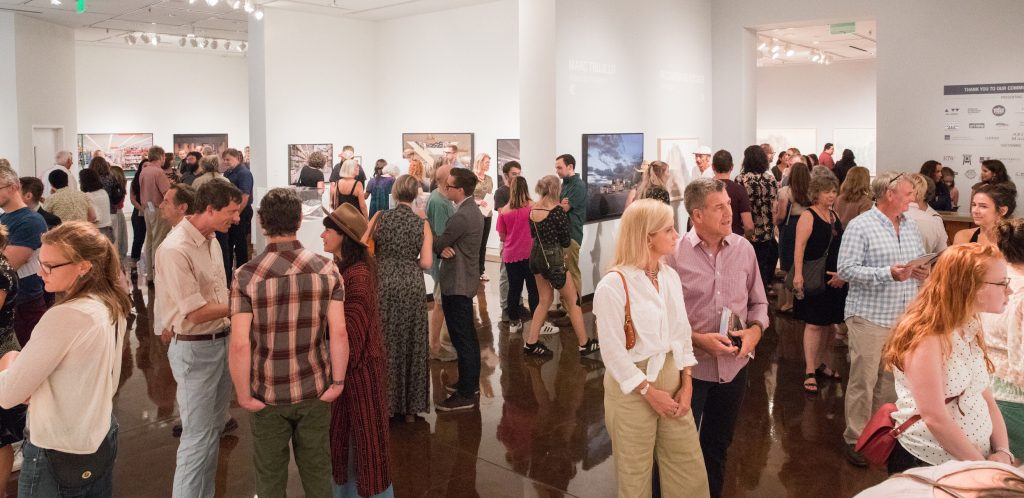

A Delphic Tale Told in Nouns
Kara Hammond describes the imagery in her paintings and drawings as “scenes of everyday human existence.” That’s as good a summary as you’re likely to find of this straightforward but strangely varied collection of suburban homes, airport buildings, storage sheds, space vehicles, office complexes, freeway ramps, trash receptacles, outdoor toilets, and other artifacts of the consumer-inflected landscape.
The work is “post-” quite a few things, to use a bit of art historical jargon. They are post-commodity art in the sense that they are not preaching about humankind’s intrusions into the natural environment but merely recording them as factually as possible. They are post-appropriation in that the recording more or less takes for granted art’s manipulation of signs, and the curious relationships that arise when painterly subjectivity meets the photographic record.
But the term post- usually implies a residue of what came before, and one still sees a skeptical, theoretical bent at work in these placid, some might say traditional-looking subjects. Images as reductive and open-ended as haikus on the individual level reveal their critical drift when seen cumulatively.
In language terms Hammond’s images aspire to a condition of pure noun-hood. Typically she centers a single subject within a bland or neutral background, avoiding arty expressionist points of view. Her rendering takes pains not to call too much attention to itself, employing no more brushing or penciling than necessary to convey a subject.
In the painting Tyvek Beach House, 2005, for example, a boxy vacation dwelling sits calmly against a stark background of sea, sand, and sky. Clearly still under construction, the house sports an outer coating of insulation panels–the “Tyvek” of the title, a synthetic material often used by the building industry. Raised on stilts, the house has no apparent means of entrance or exit; what might be the building materials for a stairway lie in the foreground.
Houses like these can be seen on beaches all along the American coastline. Cheaply constructed, many disappear after their first hurricane. The painting gives us no clues for how long the building has sat like this: for all we know the developer is in receivership and the half-completed property is rapidly decreasing in value. While its destiny may very well be to become driftwood, the time element is supplied by a viewer; the image itself is frozen and as enigmatic as an oracular blurb from ancient Delphi.
Hammond’s graphite drawings are even more noun-like in being placed against plain white backgrounds, that is, in having no surroundings with which to interact. The individual images floating in the white space of the paper are as laconic as their titles: portapotty, garbage bags, ottoman, septic tank, jetpack, airport roundabout. One thinks of Ezra Pound’s Imagist poems of the early 20th Century, which sought to reduce the frilly, convention-laden verse of an earlier era to a singular pungent picture.
Collectively, however, the nouns modify each other, as the above list suggests. The viewer inevitably starts grouping them into themes and from there imagines oppositions, such as the “high†of human technological aspirations vs. the “low” of recycled bodily waste. There are complicating factors in these dichotomies, however. For example, where does the ottoman fit in? Is it truly low or just modest? Is a ship’s toilet high tech or low tech?
The work’s wry humor, subtle and hard to convey in words, keeps interpretations from being too pompous. The understated subject matter, willfully provisional style, and a whiff of mid 20th Century “populuxe” kitsch all work in concert. When it comes down to it, putting a jetpack–a personal “rocket belt” built but never mass produced in the ’60s–in the same show with a Johnny-on-the-Spot, still the state of the art in portable evacuation, is just funny.
Someone once attempted to define a story as follows: when you say “the king died, then the queen died” you don’t have a story but when you say “the king died because the queen died” suddenly you do. Visual art doesn’t need this kind of obvious narrative hook, its pleasure comes from the union of subject and drawing, what perceptual psychologists call the instantly-perceived “gestalt” of the work, followed by a process of puzzling through what’s right in front of you.
Hammond’s subjects don’t tell an action-packed tale such as “human artifacts are gradually replacing or destroying nature.” Instead, they state plainly and coolly that this is what’s in our environment and what we live with. The noun-hood reflects the awkward state of passivity we feel when confronted with systems too large to control.
You could argue that by keeping her focus relentlessly on the artificial, she is telling not just a story but a one-sided one, but in our over-developed, ecologically skewed, genie-out-of-the-bottle world, that’s a bit like the conservatives’ argument that we must “balance” evolution and creation science. It’s a false choice to sooth those blind to their changing surroundings.
Tom Moody, New York, 2005